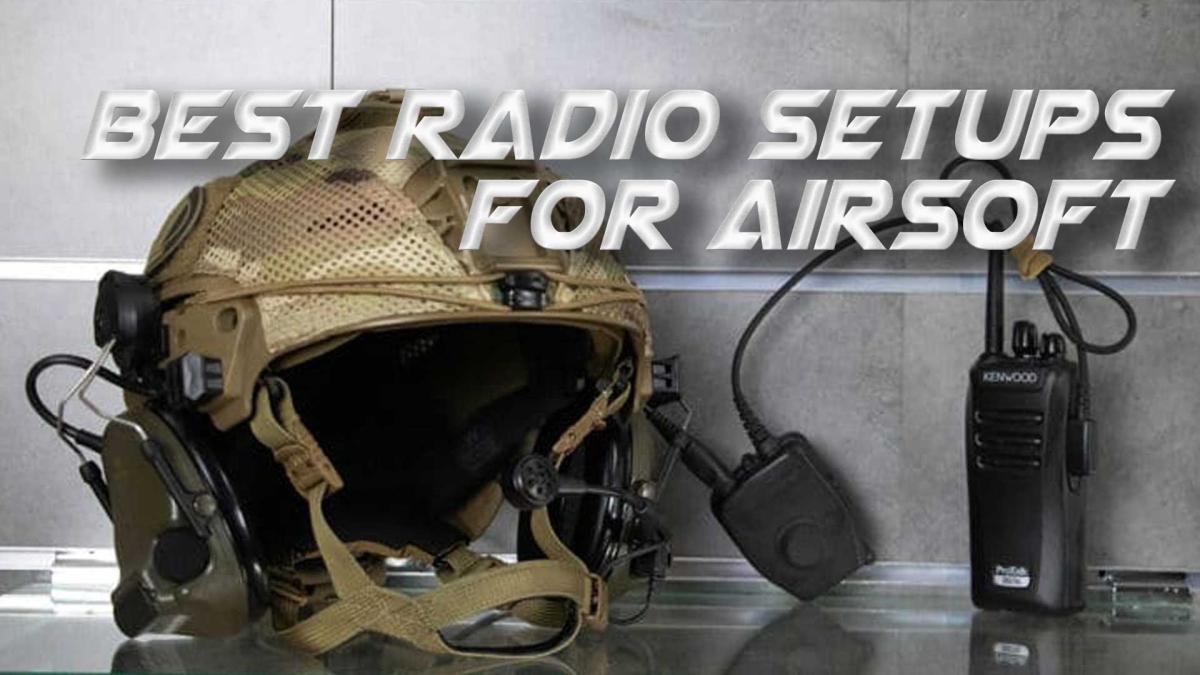Best Radio Setups for Airsoft Comms
Communications in airsoft is vital both for coordinating with your team, locating the enemy or even calling your hits, without communication you are unlikely to know where friendly and enemy players are which increases the chances of friendly fire, or be able to respond effectively to the other team’s actions.
Communications comes in several different forms, audio, visual and wireless, each with their own advantages and disadvantages. Whilst most of us easily communicate through audio by speaking or yelling at each other, this has a limited range and the other team can obviously hear your voice too. Visual communications usually come in the form of hand signals, while it is silent, hand signals require line of sight and the other player to be able to understand what the signal means which might be difficult if you are playing with strangers in a public game.
The third is wireless communications, this could be done through a cell phone by calls or text, but these methods are inconvenient to do in game or require you to know everybody’s numbers. Thus the most convenient and suitable form of wireless communications in airsoft is through radios which is precisely what this blog is about.

Why Radios for Airsoft?
Radios are the best way to instantly communicate with your teammates. It’s much clearer than trying to yell or use hand signals, and can used over longer distances. They also have greater reception than using your cell phone as those require on active signal coverage which might not be available in remote locations. Radios perform better and more reliably than any other communications system available.
What Pieces of Comms Gear Do I Need?
The most obvious piece of airsoft comms gear is naturally a radio itself, whilst not the main focus of this blog, having a functional personal radio is obviously the most important part of radio communications! While there are an endless number of affordable radios out there, few match the price and ubiquity of the legendary Baofeng UV5R. Used worldwide by airsofters, soldiers, firefighters, insurgents and more, this little radio is a great choice for any airsofter for a wide variety of reasons. First, they’re widely available and incredibly affordable, at around $40 you get a high performing radio with an extensive array of aftermarket accessories, the radio is also very rugged and with a solid construction and they are easy to program and can be set up in under five minutes.
In addition to the obvious radio, here are three items we consider essential for your airsoft comms load set up, it is essential to note that before purchasing any of these devices, make sure they are compatible with your specific radio as different radios do have different connection standards, consult the item descriptions and the specifications of your radio before making any purchase.
Item #1: Push to Talk (PTT)
One of the most important accessories for a radio is a Push to Talk (PTT). This is essentially a separate button attached to your radio within each reach that you press when you want to speak. While this may seem small, it saves you the trouble of having to reach down into your pouch to press the button on the radio, and can help avoid you pressing it when you don’t mean to. We have a variety of PTT systems available from several brands including Earmor, Rogertech and Z-Tactical which suit different situations. For example, the Roger Tech 409 Tactical PTT is focused on ease of use with just a single button to activate communications while the Z-Tactical ZSILYNX CLARUS PTT features two channel buttons and volume control for extra functionality.
Item #2: Headset and Microphone
The next most important item of airsoft comms gear is a headset and microphone, a radio without a headset will simply transmit incoming messages out loud through the speaker which could alert the other team to your position. Furthermore, without an attached microphone you will have to physically lift the radio to your mouth and speak directly into the receiver which would be an unnecessary distraction if in contact and you need to use your hands to keep engaging the enemy. Thus a headset and microphone allows for hands free private communications between players, greatly reducing the amount of distraction with minimal hassle.

Headsets come in many forms for numerous purposes, for example the Z-Tactical ZFBI Style Acoustic Headset is designed for players who wish to have a headset with a more covert profile in the style of close protection or undercover agents though at the cost of durability. The Z-Tactical Bowman III Headset with Bright Mic on the other hand is more suited to outdoor operations and allows for hands free communication on the radio without interupping your situational awareness due to its single speaker design. For players who want extra functionality, not only does the Earmor Tactical Hearing Protection Ear-Muff - FG give you the ability to listen and talk through the radio hands free, but it also comes with built in electronic hearing protection which allows you listen to your surroundings but will dim the volume if a noise surpasses 82 decibels, protecting your hearing all in a comfortable gel padded multifunctional hearing device.
Item #3: Radio Pouch
The third most important item for airsoft comms is a secure radio pouch, after all if the whole point of the other two items is to be able to use a radio hands free, this must include the radio itself! It is thus essential that the pouch not only securely holds the radio but it must also be capable of being securely attached to your plate carrier or belt kit through MOLLE loops to ensure security and ease of use. Furthermore, a decent radio pouch should also protect your radio from water or dirt, while most modern handheld radios have some form of water resistance it’s still better to ensure the device is clean and dry to ensure optimum working reliability.
What is The Best Configuration for Comms?
Ultimately the manner in which you configure your airsoft comms is almost entirely down to your personal preferences and the communications equipment you have in your possession. However, there are a few principles one should abide by and these recommendations will go a long way to ensuring optimum performance and convenience.
Config #1 PTT Position
The location of the PTT is of paramount importance when it comes to usability, if you cannot efficiently reach the button to talk to your team, you might lose valuable tactical opportunities to warn them or forward them vital information especially during intense and stressful situations like say a firefight. Ideally your PTT should be placed somewhere on your front torso or plate carrier within easy reach of your off hand, this will allow you to easily reach it on your person without having to remove your dominant hand from the grip of your weapon which provides extra readiness to any potential threats.
Config #2 Radio Position
The next is the position of your radio, assuming you have a PTT and headset, your radio does not have to be readily accessible as your PTT should already suffice for fast and efficient communications. Thus the pouch should be positioned a bit further out to the side of you plate carrier or belt kit but not to the point of inaccessibility should you need access to it to switch channels or adjust the finer settings of your radio.
How Much Should I Expect to Spend on Comms for Airsoft?
For a hobby that’s often notorious for the sheer cost of entry, radio equipment is actually surprisingly affordable. Whilst the previously mentioned Baofeng radios can cost as little as $40, PTT sets cost significantly less with the aforementioned Z-Tactical ZSILYNX CLARUS costing just $16. Headsets too are relatively affordable with the Z-Tactical Bowman III Headset with Bright Mic costing $24 though the more feature rich Earmor Tactical Hearing Protection Ear-Muff - FG costs the most at $80. Ultimately we recommend that you purchase according to your current needs and what you can afford
Is it Legal to Use Radios in Airsoft
The legality of the radios depends on where you live as some parts of the world have restrictions on the usage of specific radio frequencies that are commonly used by law enforcement or militaries. Please do check your local laws for more information for which channels you can legally use and such information should be widely available from local government websites and authorities. If you live in the US, you should only be using FRS (Family Radio Service) channels. More information about these channels can be found on the FCC website.

